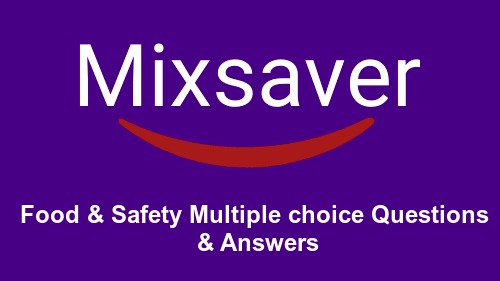1. What is the minimum temperature to which ground beef should be cooked to make sure it is free from harmful bacteria? | Food and Safety Questions
a) 220°F
b) 140°F
c) 165°F
d) 160°F
e) 350°F
Ans: d
2. Which of the following is NOT a critical factor in the growth of dangerous food-borne bacteria? | Food and Safety Questions
a) Temperature
b) Time
c) Moisture
d) Altitude
e) pH Level (Acidity)
Ans: d
3. How cold should your refrigerator be to minimize the risk of food poisoning? | Food and Safety Questions
a) 35°F or colder.
b) 40°F or colder.
c) 45°F or colder.
d) 50°F or colder.
e) 55°F or colder.
Ans: b
4. Which of the following bacteria are responsible for causing the greatest number of food borne illnesses? | Food and Safety Questions
a) E. coli
b) Salmonella
c) Botulism
d) Listeria
e) Indigestion
Ans: b
5. Which of the following is an acceptable technique for thawing a frozen turkey? | Food and Safety Questions
a) In the refrigerator overnight.
b) In the microwave.
c) On the kitchen counter.
d) Submerging it in cold water overnight.
e) Leaving it in the garage overnight.
Ans: a
6. Bacteria multiply quickly in the Food Temperature Danger Zone. What is the temperature range for this zone? | Food and Safety Questions
a) Between 30°F and 130°F.
b) Between 45°F and 145°F.
c) Between 40°F and 140°F.
d) Between 40°F and 150°F.
e) Between 50°F and 120°F.
Ans: c
7. When it comes to food safety, which of the following is the best material for a cutting board? | Food and Safety Questions
a) Wood
b) Plastic or acrylic
c) Glass
d) Velcro
e) It doesn't matter. All this science stuff is just silly.
Ans: b
8. When using chlorine bleach to sanitize cutting boards, how much bleach should be added to each gallon of water? | Food and Safety Questions
a) 1 cup
b) 1 teaspoon
c) 1 tablespoon
d) 1 quart
Ans: c
9. Which of the following signs indicates that food has been contaminated by dangerous bacteria such as E. coli or salmonella? | Food and Safety Questions
a) Bad smell
b) Discoloration
c) Off taste
d) Slimy surface
e) None of the above
Ans:e
10. Which of the following groups of people have a higher than normal chance of contracting a case of food poisoning? | Food and Safety Questions
a) Very young children
b) Pregnant women
c) The elderly
d) Persons with compromised immune systems
e) All of the above
Ans: e
11. At what temperature should your refrigerator be maintained? | Food and Safety Questions
A. 60°F
B. 45°F
C. 40°F
D. None of the above
Ans: c
12. In order to properly wash your hands before or after handling food, exactly what is the minimum amount of time you should wash your hands under running water? | Food and Safety Questions
A. 10 sec
B. 20 sec
C. 1 minute
D. None of the above
Ans: b
13. Which of the following bacteria are responsible for causing the greatest number of foodborne illnesses? | Food and Safety Questions
A. Salmonella
B. Campylobacter
C. E. coli
D. None of the above
Ans: b
14. Which is the minimum temperature at which hot foods on a buffet should be maintained? | Food and Safety Questions
A. 212°F
B. 180°F
C. 140°F
D. None of the above
Ans: C
15. The majority of foodborne illnesses are a result of which of the following? | Food and Safety Questions
A. Improper handling of foods by the consumer
B. Improper handling of foods in restaurants or food service settings
C. Improper processing of foods by the manufacturer
D. None of the above
Ans: A
16. When sanitizing dishclothes or cutting boards at home using chlorine bleach, how much bleach should be added, per quart of water? | Food and Safety Questions
A. 1 teaspoon
B. ½ cup
C. ½ quart
D. None of the above
Ans: A
17. Which of the following ways is NOT a safe way to defrost raw meat? | Food and Safety Questions
A. In the refrigerator
B. On the counter
C. In the microwave
D. None of the above
Ans: B
18. What is the minimum temperature ground beef should be cooked to in order to assure safety? | Food and Safety Questions
A. 155°F
B. 160°F
C. 165°F
D. None of the above
Ans: B
19. Which food is associated with the most cases of foodborne illness due to Salmonellosis? | Food and Safety Questions
A. Raw chicken
B. Raw eggs
C. Raw vegetables
D. None of the above
Ans: B
20. If food looks ok and smells ok it's safe to eat. | Food and Safety Questions
A. True
B. False
Ans: B
21. Eating food after the 'best before' date won't hurt
A. True
B. False
Ans: A
22. 'Use by' dates are there to make you buy more
A. True
B. False
Ans: B
23. Stick to the 'five second rule' and you'll be ok
A. True
B. False
Ans: B
24. Plastic chopping boards are more hygienic than wooden ones
A. True
B. False
Ans: B
25. You don't need to wash raw chicken before you cook it
A. True
B. False
Ans: A
26. If you've got a 'dodgy' stomach it's usually from the last thing you ate
A. True
B. False
Ans: B
27. Most food poisoning is from 'dodgy' restaurants and takeaways
A. True
B. False
Ans: B
28. Food poisoning isn't serious, it just means an upset stomach
A. True
B. False
Ans: B
29. Steak's ok rare – as long as the outside is brown
A. True
B. False
Ans: A
30. It's best to serve burgers pink in the middle
A. True
B. False
Ans: B
31. Cooked rice can't be kept as long as other leftovers
A. True
B. False
Ans: A
32. Hands should be washed with water and soap for at least:
A. 5 seconds
B. 20 seconds
C. 15 Seconds
D. 10 Seconds
Ans: B
33. Is it safe to put cooked food on a plate that held raw meat, poultry or seafood?
A. Yes
B. No
Ans: B
34. Food should not be left at room temperature for more than:
A. 2 hours
B. 10 hours
C. 5 hours
D. 6 hours
Ans: A
35. You can’t get food poisoning if you thoroughly cook your food and eat it promptly.
A. True
B. False
Ans: B
36. Which of the following long-term complications can result from food poisoning?
A. Rheumatoid arthritis
B. Kidney disease
C. Nerve damage
D. All of the above
Ans: D
37. The first symptoms of food poisoning can occur:
A. Immediately
B. Within two to 48 hours after eating
C. From two days to a week after eating
D. Any of the above
Ans: D
38. You should contact a doctor for possible food poisoning if you experience:
A. Bloody diarrhea or pus in the stool
B. Headache, stiff neck, and fever
C. Diarrhea that hasn’t let up after three days
D. Weakness, numbness, or tingling, usually in the arms or legs but sometimes around the mouth
E. Any of the above
Ans: E
39. Which of these groups has a greater risk of getting food poisoning than the others?
A. Smokers
B. Heavy antacid users
C. People who drink alcohol at least once a week
D. They all have an equally high risk
Ans: B
40. How many Salmonella bacteria does it take to give you food poisoning?
A. As few as half a dozen
B. At least one thousand
C. At least one million
Ans: A
41. Which has been linked to outbreaks of food poisoning caused by E. coli O157:H7?
A. Apple juice
B. Ground beef
C. Lettuce
D. All of the above
Ans: D
42. More than ten percent of all bottled water starts out as tap water.
A. True
B. False
Ans: A
43. An "EPA-approved" water filter meets minimum standards set by the Environmental Protection Agency for removing bacteria and other harmful substances.
A. True
B. False
Ans: B
44. To avoid food poisoning from E. coli O157:H7, cook ground beef until:
A. The internal temperature reaches 160°F
B. The juices run clear
C. No more pink color is evident
D. Any of the above
Ans: A
45. When you cook meat or poultry or casseroles that contain meat or poultry what minimum oven temperature should you use?
A. 125°F
B. 225°F
C. 325°F
D. 425°F
Ans: C
46. What’s an easy way to reduce the amount of potentially cancer-causing heterocyclic amines (HCAs) that form when chicken is broiled or grilled?
A. Keep the chicken refrigerated until just before cooking
B. Remove the skin after the chicken is cooked
C. Remove the skin before the chicken is cooked
D. Before broiling or grilling the chicken, pre-cook it in a microwave for a few minutes and pour off the juices
E. Any of the above
Ans: D
47. Eighty percent of all food poisoning from meat and poultry is caused by:
E. coli O157:H7
A. Salmonella and Campylobacter
B. Staphylococcus
C. Clostridium
Ans: A
48. Prions are the agents that appear to cause a deadly disease in people who eat meat from cattle with "mad cow disease." Which cooking method for beef destroys prions?
A. Cooking until the internal temperature reaches 180°F
B. Broiling for at least 15 minutes
C. Pre-cooking in a microwave for three minutes and pouring off the juices before broiling or grilling
D. Cooking until no pink color remains and the juices run clear
E. Any of the above
F. None of the above
Ans: F
49. It’s safe to eat rare hamburgers if the ground beef has been irradiated.
A. True
B. False
Ans: B
50. How can you tell if an egg is contaminated with Salmonella?
A. The shell is cracked
B. The shell has dried chicken feces on it
C. The egg hasn’t been kept refrigerated
D. You can’t tell
E. Any of the above
Ans: D





